Podcast
Questions and Answers
What is a characteristic of lysogeny in bacteria?
What is a characteristic of lysogeny in bacteria?
- Bacteriophages can only infect gram-positive bacteria.
- Bacteriophages can cause lysis of all bacterial cells.
- Bacteriophages integrate their DNA into the bacterial genome. (correct)
- Bacteriophages replicate independently of the host's DNA.
What causes symptoms in fungal diseases?
What causes symptoms in fungal diseases?
- Destruction of red blood cells.
- Massive immune response to viruses.
- Direct infection of the bloodstream.
- Production of toxins, allergic reactions, or tissue invasion. (correct)
Which of the following best defines a portal of exit?
Which of the following best defines a portal of exit?
- The mechanism by which a pathogen is engulfed by immune cells.
- The initial site of pathogen entry into the body.
- The site through which a pathogen exits the host to infect another individual. (correct)
- The location where antibiotics are administered.
How do helminthic diseases primarily cause health issues?
How do helminthic diseases primarily cause health issues?
What is a major characteristic of protozoan diseases?
What is a major characteristic of protozoan diseases?
Which of the following is the most common portal of entry for pathogens?
Which of the following is the most common portal of entry for pathogens?
What does ID50 represent in the context of infectious diseases?
What does ID50 represent in the context of infectious diseases?
Which structure is NOT used by microbes for adhesion to host cells?
Which structure is NOT used by microbes for adhesion to host cells?
How do capsules contribute to the pathogenicity of bacteria?
How do capsules contribute to the pathogenicity of bacteria?
What is the significance of a low LD50 in a pathogen?
What is the significance of a low LD50 in a pathogen?
Which of the following is an example of a pathogen entering through the gastrointestinal tract?
Which of the following is an example of a pathogen entering through the gastrointestinal tract?
What role do fimbriae play in bacterial infection?
What role do fimbriae play in bacterial infection?
Which of the following is NOT a method of pathogen entry into the body?
Which of the following is NOT a method of pathogen entry into the body?
What is the primary function of peptidoglycan in bacterial cell walls?
What is the primary function of peptidoglycan in bacterial cell walls?
Which enzyme is produced by Staphylococcus aureus to avoid phagocytosis?
Which enzyme is produced by Staphylococcus aureus to avoid phagocytosis?
What is antigenic variation?
What is antigenic variation?
How do bacteria typically use the host's cytoskeleton for entry into cells?
How do bacteria typically use the host's cytoskeleton for entry into cells?
Which mechanism do bacteria use to prevent destruction by phagocytosis?
Which mechanism do bacteria use to prevent destruction by phagocytosis?
What role do siderophores play in bacterial infection?
What role do siderophores play in bacterial infection?
How do exotoxins primarily damage host cells?
How do exotoxins primarily damage host cells?
What distinguishes endotoxins from exotoxins?
What distinguishes endotoxins from exotoxins?
Which type of toxin stimulates excessive immune responses?
Which type of toxin stimulates excessive immune responses?
What is the purpose of the Limulus Amebocyte Lysate (LAL) assay?
What is the purpose of the Limulus Amebocyte Lysate (LAL) assay?
What defines the function of plasmids in bacterial pathogenicity?
What defines the function of plasmids in bacterial pathogenicity?
Which of the following is a consequence of microbial direct damage?
Which of the following is a consequence of microbial direct damage?
How do leukocidins function in the context of bacterial pathogenicity?
How do leukocidins function in the context of bacterial pathogenicity?
Flashcards
What is ID50?
What is ID50?
The number of microbes required to infect 50% of a population.
What is LD50?
What is LD50?
The number of microbes required to cause death in 50% of a population.
What are portals of entry?
What are portals of entry?
These are the sites where microorganisms enter the body.
What are mucous membranes?
What are mucous membranes?
Signup and view all the flashcards
What are adhesins?
What are adhesins?
Signup and view all the flashcards
What is the glycocalyx?
What is the glycocalyx?
Signup and view all the flashcards
What does a capsule do?
What does a capsule do?
Signup and view all the flashcards
What are fimbriae and pili?
What are fimbriae and pili?
Signup and view all the flashcards
Portal of Entry
Portal of Entry
Signup and view all the flashcards
Portal of Exit
Portal of Exit
Signup and view all the flashcards
Lysogenic Bacteriophages
Lysogenic Bacteriophages
Signup and view all the flashcards
Fungal Disease Symptoms
Fungal Disease Symptoms
Signup and view all the flashcards
Helminthic Disease Symptoms
Helminthic Disease Symptoms
Signup and view all the flashcards
Peptidoglycan
Peptidoglycan
Signup and view all the flashcards
Mycolic Acid
Mycolic Acid
Signup and view all the flashcards
Lipopolysaccharide (LPS)
Lipopolysaccharide (LPS)
Signup and view all the flashcards
Kinases
Kinases
Signup and view all the flashcards
Hyaluronidase
Hyaluronidase
Signup and view all the flashcards
Collagenase
Collagenase
Signup and view all the flashcards
Antigenic Variation
Antigenic Variation
Signup and view all the flashcards
Receptor-mediated Endocytosis or Phagocytosis
Receptor-mediated Endocytosis or Phagocytosis
Signup and view all the flashcards
Bacterial Adhesins
Bacterial Adhesins
Signup and view all the flashcards
Siderophores
Siderophores
Signup and view all the flashcards
Direct Damage
Direct Damage
Signup and view all the flashcards
Toxins Produced by Bacteria
Toxins Produced by Bacteria
Signup and view all the flashcards
Exotoxins
Exotoxins
Signup and view all the flashcards
Endotoxins
Endotoxins
Signup and view all the flashcards
A-B Toxins
A-B Toxins
Signup and view all the flashcards
Membrane-disrupting Toxins
Membrane-disrupting Toxins
Signup and view all the flashcards
Study Notes
Pathogenicity Overview
- Pathogens enter the body through specific portals, including mucous membranes (respiratory, gastrointestinal, genitourinary, conjunctiva) and skin (cuts, abrasions, hair follicles).
- The parenteral route involves direct entry into tissues via punctures, injections, or bites.
Virulence Factors
- ID50 (Infectious Dose 50): The number of pathogens needed to infect 50% of a population.
- LD50 (Lethal Dose 50): The number of pathogens needed to kill 50% of a population.
- Lower ID50/LD50 values indicate higher virulence.
Adherence Mechanisms
- Microbes adhere to host cells using adhesins, glycocalyx (e.g., capsules), fimbriae, and pili.
- Adhesins are bacterial surface proteins that bind to host cell receptors.
- Glycocalyx enhances adherence to surfaces, forming biofilms.
- Fimbriae and pili are hair-like appendages enabling adherence.
Evasion of the Immune System
- Capsules: Polysaccharide or protein layers that prevent phagocytosis.
- Cell wall components:
- Peptidoglycan can contribute to pathogenicity.
- Mycolic acid in Mycobacteria prevents digestion within phagocytes.
- Lipopolysaccharide (LPS) in Gram-negative bacteria triggers inflammatory responses.
- Coagulases: Cause blood clotting, hindering immune detection.
- Kinases: Break down fibrin, allowing bacterial spread.
- Hyaluronidase: Breaks down connective tissue, aiding spread.
- Collagenase: Breaks down collagen in connective tissue, aiding spread.
Antigenic Variation
- Pathogens alter their surface proteins to evade the host immune response (e.g., Influenza virus).
Internalization Mechanisms
- Some bacteria use the host cell's cytoskeleton (actin filaments) to enter cells via receptor-mediated endocytosis or phagocytosis.
- Examples include Salmonella interacting with host receptors and inducing membrane ruffling.
Avoiding Phagocytosis
- Bacteria evade phagocytes through capsules, leukocidins, preventing phagosome-lysosome fusion, or escaping from the phagosome.
Nutrient Acquisition
- Siderophores are small molecules that bind iron, helping bacteria acquire this essential nutrient for growth (e.g., E. coli).
Direct and Toxin-Mediated Damage
- Direct damage: Microbes physically damage tissues by releasing enzymes that break down tissue constituents (e.g., Streptococcus pyogenes).
- Toxin production involves exotoxins secreted by pathogenic bacteria and endotoxins, parts of Gram-negative cell walls.
Toxin Types
- Exotoxins: Protein toxins damaging or destroying host cells, often very potent (e.g., Diphtheria toxin).
- Endotoxins: Components of Gram-negative cell walls (LPS), released on bacterial death. These trigger strong inflammatory responses, potentially causing fever, shock, and death (e.g., E. coli LPS).
Mechanisms of Action
- A-B toxins: Two-part toxins (A = active, B = binding), damaging cells by disrupting cellular functions.
- Membrane-disrupting toxins: Damage host cell membranes.
- Superantigens: Cause excessive immune responses by activating large numbers of T cells.
- Genotoxins: Damage host cell DNA, leading to mutations and cancer.
Diagnostic Tools
- LAL assay: Detects endotoxins (LPS) in pharmaceuticals and medical devices using horseshoe crab blood cells.
Genetic Factors
- Plasmids: Carry genes for antibiotic resistance, virulence factors, or toxins (e.g., Shiga toxin in E. coli).
- Lysogeny: Bacteriophages integrating their DNA into the bacterial genome, potentially causing toxin production (e.g., Corynebacterium diphtheria).
Causation of Symptoms
- Fungal, protozoan, helminthic, and algal diseases’ symptoms arise from toxin production, allergic reactions, tissue invasion, parasite presence, or toxin release.
Portal of Entry vs. Exit
- Portal of entry is the site of pathogen entry into the body.
- Portal of exit is the site of pathogen exit from the body.
Studying That Suits You
Use AI to generate personalized quizzes and flashcards to suit your learning preferences.




